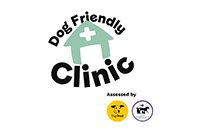Dogs across London, Hertfordshire, and Cambridge, by their very nature, make for a wonderful companion because of their boundless enthusiasm, fierce loyalty and natural playfulness. But when carrying that little bit of extra weight, your dog’s energy can be reduced, making them less curious and more lethargic. At Village Vets we can support you with any questions you may have relating to your dog’s weight and diet so do ask during your next visit to us.
Book a weight check consultation with us at Village Vets
Find out more

It won't surprise you that the common reason for canine obesity is overeating and a corresponding lack of exercise. Unlike us, your canine companion cannot simply decide to take more exercise or eat less, so it’s crucial we, as their owners, employ the lifestyle changes needed to maintain a healthy weight.
Your veterinary team at Village Vets can help you with this. After conducting a physical examination and asking you some questions about your dog’s lifestyle, your vet will be able to establish a realistic and long-term sustainable weight-loss plan. It’s often as simple as encouraging more exercise and reducing calorie intake.
Make your move
Exercise with your dog can be fun! Walks in the park, playing in the garden and using a dog toy with some of their kibble inside will keep your dog strong, healthy and entertained. Older dogs may only be able to potter owing to older joints, but this will loosen them up and give their muscles a little workout.
Here are a range of ideas of how you can maintain their fitness at home, too:
- Focus on agility by creating your own obstacle course:
This clearly depends on the space you have available, however creating something for your dog to jump over, run through or skip around is a fun way to introduce exercise at home – either indoors or in the garden. You don’t have to have professional equipment, using soft items such as cushions can provide them with a low-risk obstacle. - Play hide and seek:
Tell your dog to stay in a room, go and hide and then call them. They’ll use a range of their senses trying to find you – plus providing additional joy when they do. Just don’t get overly excited and give away your hiding place too soon… - Playing games to earn rewards:
By hiding their treats around the house, you can make them earn their reward – not only allowing them to exercise but keeping them mentally active in the process. There are also a range of interactive toys available which will stimulate both their mind and body. - Try and teach your dog something new:
If you never have the time to try and teach your dog a new trick or an activity – now might be the ideal time. Just remember to not overly reward the activity, otherwise, you’ll defeat the object. You could use a proportion of their daily food allowance for treats. - Get some new toys:
There’s lots of research that suggests that dogs love new toys. If they’re bored with the old ones, why not put them away and give them something new to play with? By rotating which toys they have available – it will maintain their interest and keep them active. - Play fetch:
Do you have the space to play fetch with your dog? If you can find a space to throw a ball or toy, your dog will love to return it… or maybe now is the time to try and train them to return it? Maybe down your hallway or from inside the house to out?
Rewarding behaviour is a good way of encouraging your dog to participate in activities. However, overfeeding your pet could result in obesity – which can result in greater stress on bones, heart, lungs and other organs. Reducing after-dinner scraps and reducing treats in-between mealtimes will help.
For any questions you may have, please book one of our weight clinics and speak to our friendly team at Village Vets.





